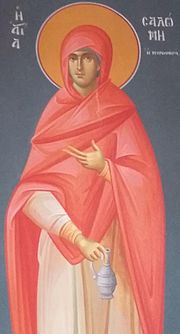
Back حاملات الطيب Arabic حاملات الطيب ARZ Miróforas Spanish مربهدستان Persian Myrophores French Para pembawa mur ID Mirofore Italian Myrraberarane NN Portadores de Mirra Portuguese Mironosițe Romanian




In Eastern Orthodox Christian tradition the Myrrhbearers (Greek: Μυροφόροι; Latin: Myrophora; Serbian: мироноснице; Church Slavonic: Жены́-мѷроно́сицы; Romanian: mironosițe) are the individuals mentioned in the New Testament who were directly involved in the burial or who discovered the empty tomb following the resurrection of Jesus. The term traditionally refers to the women who came with myrrh to the tomb of Christ early in the morning to find it empty. Also included are Joseph of Arimathea and Nicodemus, who took the body of Jesus down from the cross, anointed it with myrrh and aloes, wrapped it in clean linen, and placed it in a new tomb.[a] In Western Christianity, the women at the tomb, the Three Marys or other variants are the terms normally used.
Cite error: There are <ref group=lower-alpha> tags or {{efn}} templates on this page, but the references will not show without a {{reflist|group=lower-alpha}} template or {{notelist}} template (see the help page).